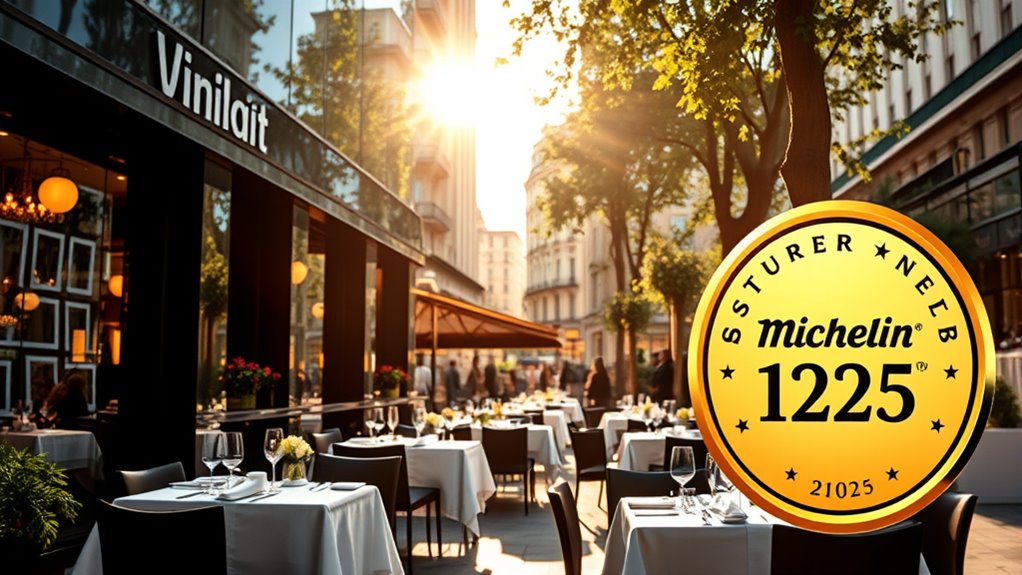In 2025, Michelin’s guide features exciting new starred restaurants worth your trip, from Denmark’s innovative PAZ using local Faroese ingredients to France’s diverse regional gems blending tradition and modernity. New York City shines with fresh stars, including Korean and Southeast Asian cuisines. Many establishments focus on sustainability, earning Green Stars and showcasing eco-friendly practices. If you keep exploring, you’ll discover even more on the cutting edge of culinary innovation, regional pride, and responsible gastronomy.
Key Takeaways
- Denmark’s PAZ in Tórshavn earned 2 Michelin stars shortly after opening, highlighting innovative regional cuisine and sustainability.
- France added 57 new one-star restaurants across diverse regions, showcasing local ingredients and culinary fusion.
- Over 100 restaurants worldwide received Green Stars in 2025, emphasizing eco-friendly sourcing and sustainable practices.
- NYC launched 14 new Michelin-starred restaurants, including the first Korean 3-star, reflecting culinary diversity and innovation.
- Smaller towns in France, like Saint-Méloir-des-Ondes, now host prestigious three-star venues, celebrating regional ingredients and storytelling.
Denmark’s Culinary Vanguard: PAZ and Beyond
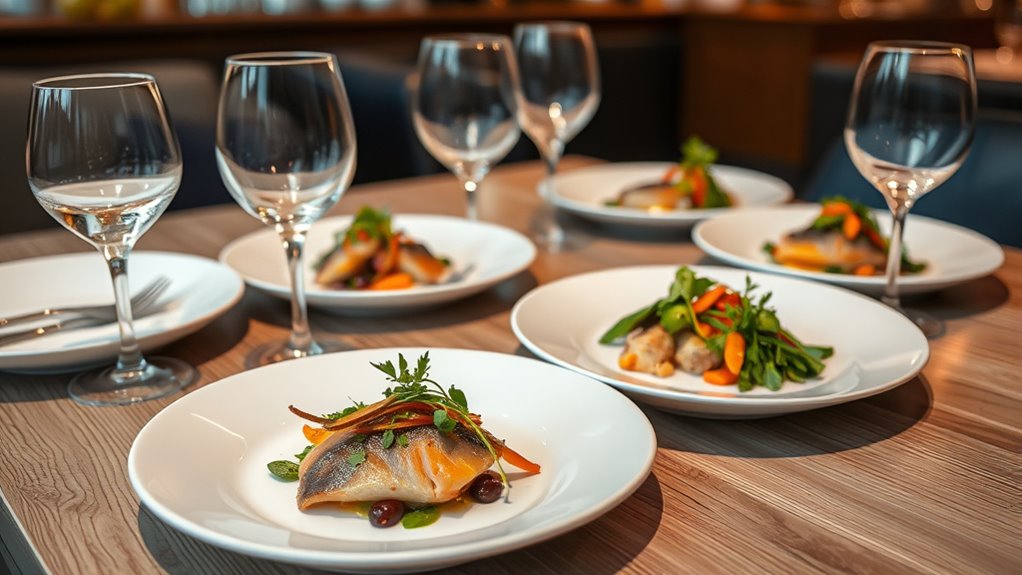
Have you heard how Denmark is redefining its culinary scene? PAZ, located in Tórshavn, exemplifies this shift by earning two Michelin stars just seven weeks after opening. Led by Chef Poul Andrias Ziska, the restaurant emphasizes local ingredients from the Faroe Islands’ land and sea. You’ll notice how their culinary craftsmanship transforms traditional Faroese recipes into innovative dishes that celebrate regional heritage. The minimalist Nordic interior creates an immersive dining experience, highlighting seasonality and sustainability. PAZ’s focus on local ingredients reflects Denmark’s broader commitment to responsible, mindful gastronomy. This approach not only elevates Faroese cuisine but also positions Denmark as a leader in Nordic culinary innovation, blending tradition with modern craftsmanship. It’s a bold step into the future of sustainable, locally driven fine dining. Denmark’s broader commitment to responsible, mindful gastronomy is reflected in many of its top restaurants, emphasizing sustainability and local sourcing. Additionally, their emphasis on regional ingredients showcases a dedication to authentic, sustainable culinary practices.
France’s Expanding Fine Dining Horizons
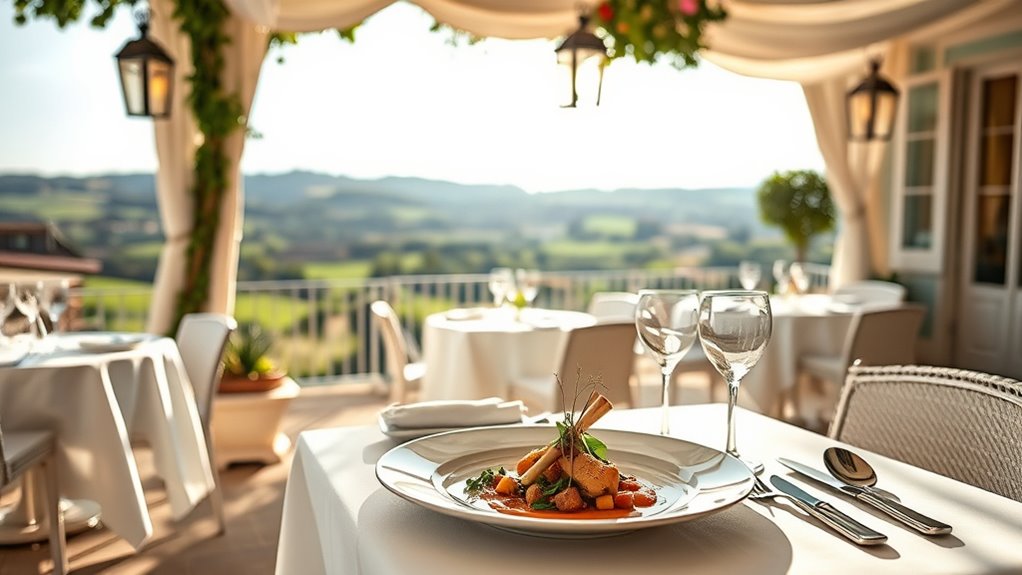
France’s culinary scene is growing more diverse and innovative than ever, with new Michelin-starred restaurants appearing across all regions. You’ll notice an emphasis on local ingredients, international influences, and sustainability in these latest recognitions. This expansion highlights how French fine dining continues to evolve while respecting its rich regional traditions. Overall, 57 new restaurants have earned one Michelin star in France for 2025, reflecting the country’s dynamic and expanding gastronomic landscape.
Regional Culinary Diversity
What does the 2025 Michelin guide reveal about France’s culinary landscape? It highlights remarkable regional culinary diversity, with every area gaining representation through new starred restaurants. You’ll find vibrant examples of cultural fusion, like Metz’s Yozora blending Japanese flavors with local ingredients, and Corsica’s Finestra and Le Charlie showcasing island cuisine. This diversity emphasizes ingredient provenance, with chefs celebrating regional terroirs—from Basque influences at Ekaitza and Lore Ttipia to Provençal flavors in Bonnieux. The guide also spotlights scenic destinations, such as mountain eateries in Auvergne-Rhône-Alpes and coastal venues in Biarritz. Whether in urban hubs or rural settings, the new stars reflect France’s rich gastronomic tapestry, where local identity and cultural fusion come together, proving that fine dining’s expanding horizons truly span the country’s diverse regions.
Innovation and Sustainability
The 2025 Michelin guide highlights a significant shift toward innovation and sustainability in France’s fine dining scene, with over 100 restaurants earning the prestigious Green Star for sustainable practices. You’ll notice chefs emphasizing ethical ingredient sourcing, local and seasonal produce, and waste reduction through organic composting and eco-friendly methods like permaculture gardens. Many restaurants incorporate culinary history by using primitive techniques such as wood-fired cooking, blending tradition with eco-conscious innovation. These practices deepen your connection to local culture and ingredients, reducing environmental impact. The Green Star award encourages restaurants to adopt environmentally responsible practices, making sustainability a core part of their culinary identity. Incorporating natural materials such as reclaimed wood and stone in restaurant design further emphasizes eco-consciousness and authenticity. Here’s a snapshot of their approaches:
| Region | Sustainability Focus | Unique Technique |
|---|---|---|
| Paris | Urban organic gardens | Micro-filtered water |
| Provence | Local foraging and zero waste | Wood-fired cooking |
| Brittany | Rustic, nature-focused menus | Primitive cooking |
| Lyon | Craftsmanship in tableware and tools | Minimal packaging |
| Bordeaux | Historic spaces with eco-renewal | Permaculture gardens |
This movement redefines French haute cuisine’s ecological role.
New York City’s Freshest MICHELIN Additions
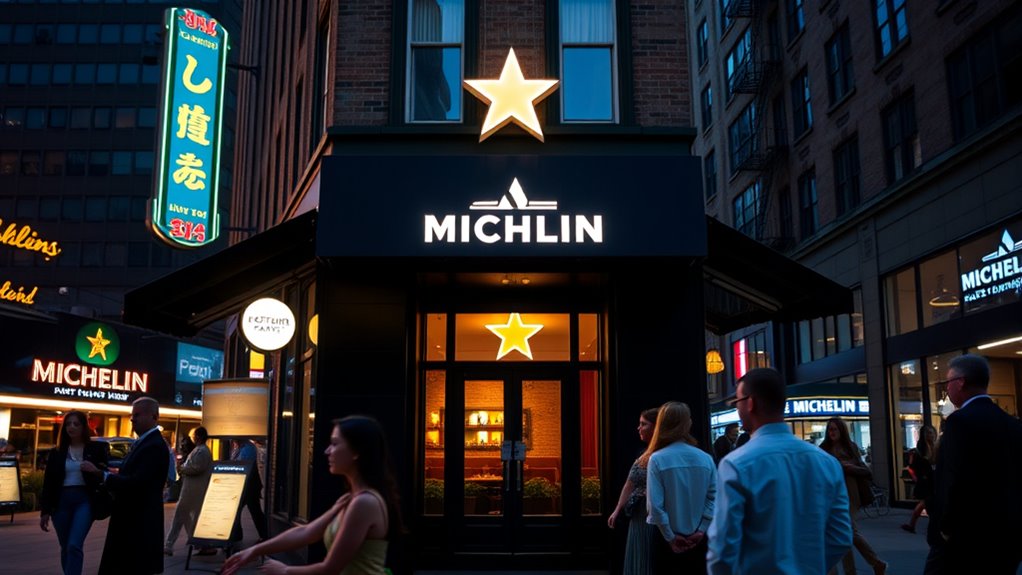
This year’s NYC Michelin guide highlights exciting new openings and culinary debuts that are reshaping the city’s food scene. From fresh restaurants earning their first stars to notable newcomers making a splash, there’s plenty to explore. These additions demonstrate the city’s ongoing evolution and diverse gastronomic landscape. Jungsik, the first Korean restaurant in NYC to earn three stars, continues to set a high standard for innovative Korean cuisine outside Seoul.
Recent Restaurant Openings
The recent openings in New York City highlight a vibrant and diverse culinary scene, with 14 new restaurants earning recognition in the 2025 Michelin Guide. These fresh additions span neighborhoods like Bay Ridge, East Village, and Williamsburg, showcasing everything from farm-to-table concepts to spots helmed by celebrity chefs.
- Yemenat in Bay Ridge serves authentic Middle Eastern dishes, emphasizing traditional flavors.
- Kabawa in East Village offers a modern take on classic cuisine, blending tradition with innovation.
- Glin Thai Bistro in Fort Greene highlights Southeast Asian influences gaining Michelin recognition.
- Enso in Williamsburg reflects the neighborhood’s eclectic, farm-to-table approach, attracting food enthusiasts.
These openings reveal NYC’s ongoing commitment to culinary diversity, with new venues elevating both local and international cuisines.
Notable Culinary Debuts
Recent restaurant openings in New York City highlight the city’s ongoing importance and innovation in the culinary scene. These notable debuts reflect a deepening culinary history, blending tradition with modern kitchen technology. Jungsik’s three-star Korean cuisine elevates cultural storytelling through refined techniques, while Yemenat’s authentic Yemeni dishes foster community and sharing. Hungry Thirsty introduces vibrant southern Thai flavors, expanding ethnic diversity. The following table illustrates how these restaurants symbolize culinary evolution:
| Tradition | Innovation | Community |
|---|---|---|
| Culinary history | Kitchen technology | Sharing culture |
| Classic flavors | Modern techniques | Family-style dishes |
| Cultural roots | Contemporary presentation | Social dining |
Furthermore, the integration of modern technology in these establishments showcases how innovation continues to shape culinary experiences in New York. These debuts demonstrate New York’s commitment to honoring culinary heritage while pushing boundaries with new technology and diverse influences.
The Rise of Sustainable and Green Stars in 2025
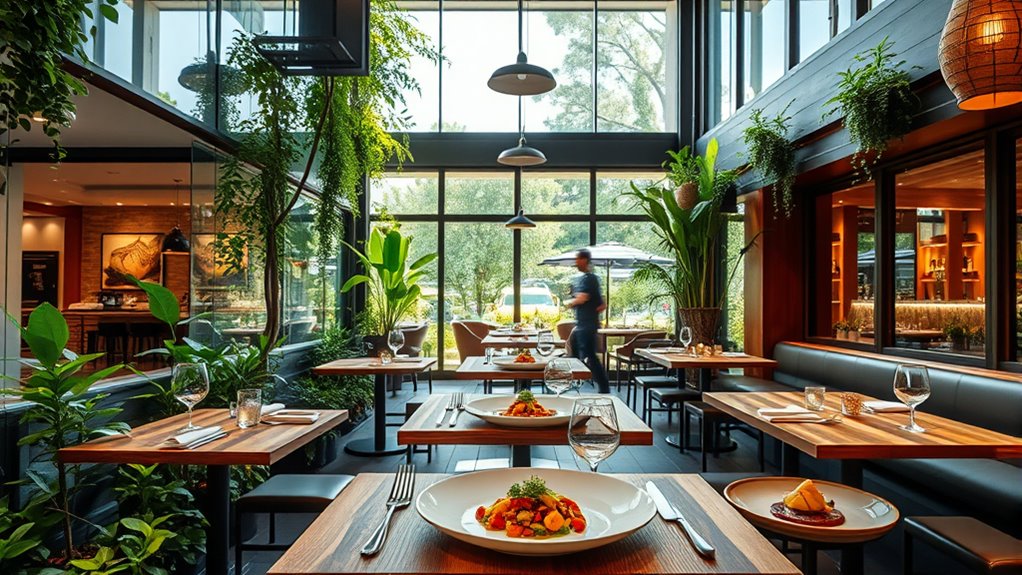
As sustainability becomes a central focus in the culinary world, 2025 marks a significant rise in Michelin Green Stars awarded to restaurants committed to eco-friendly practices. You’ll see more establishments leading in sustainable gastronomy, with a focus on eco friendly sourcing and waste reduction strategies. These restaurants set new standards for environmentally responsible dining and influence the industry worldwide. Utilization of advanced fraud detection techniques is also being adopted by many to ensure secure transactions and protect both customers and businesses.
- Enclos in Sonoma earned a Green Star for its sustainable approach.
- Sons & Daughters in San Francisco received recognition for their eco-conscious practices.
- California now leads North America with 17 Green Stars.
- The growth trend reflects a broader shift toward greener food industry standards.
This rise emphasizes the importance of environmental responsibility, encouraging more restaurants to adopt sustainable practices for a better future.
Regional Gems: Spotlight on France’s Smaller Towns
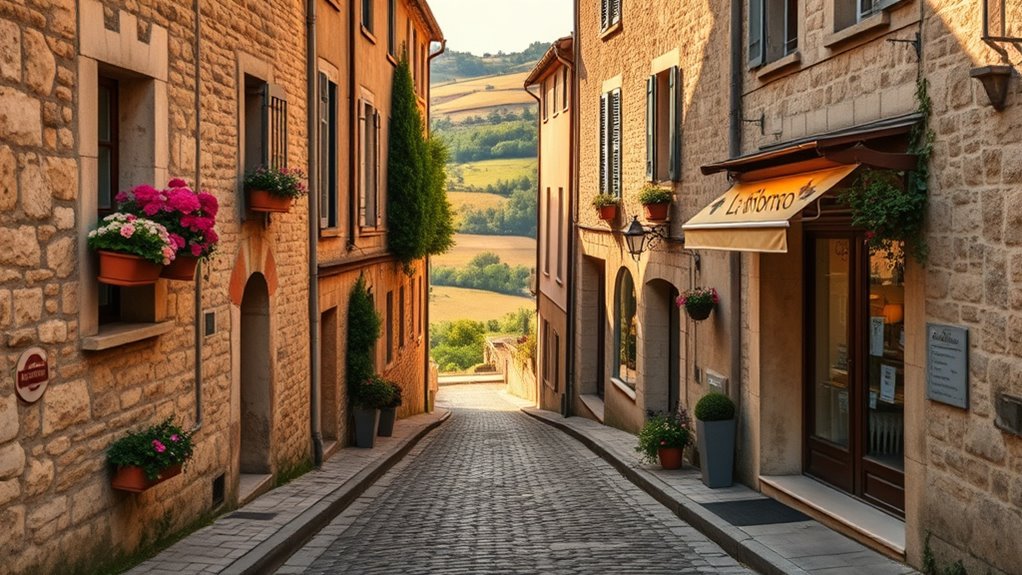
Michelin’s 2025 guide highlights a remarkable expansion of haute cuisine into smaller French towns, reshaping perceptions of regional dining excellence. You’ll find three-star restaurants like Le Coquillage in Saint-Méloir-des-Ondes, celebrating coastal culinary traditions with local ingredients such as Breton blue lobster and spider crab. These establishments emphasize regional gastronomy beyond Paris, showcasing family legacies and storytelling through local ingredients. The guide’s 125th edition includes two new three-star venues, increasing regional representation.
| Town | Cuisine Focus | Notable Features |
|---|---|---|
| Saint-Méloir-des-Ondes | Coastal, seafood | Tradition meets innovation |
| Langres | Regional, hearty dishes | Local ingredients, technique |
| Rouvres-en-Xaintois | Rustic, local flavors | Family culinary legacy |
| Steige | Alsace-inspired | Modern techniques, ingredients |
| Sargé-sur-Braye | Traditional, natural | Sustainable, minimalist approach |
American Culinary Innovation: Top New Entrants in 2025
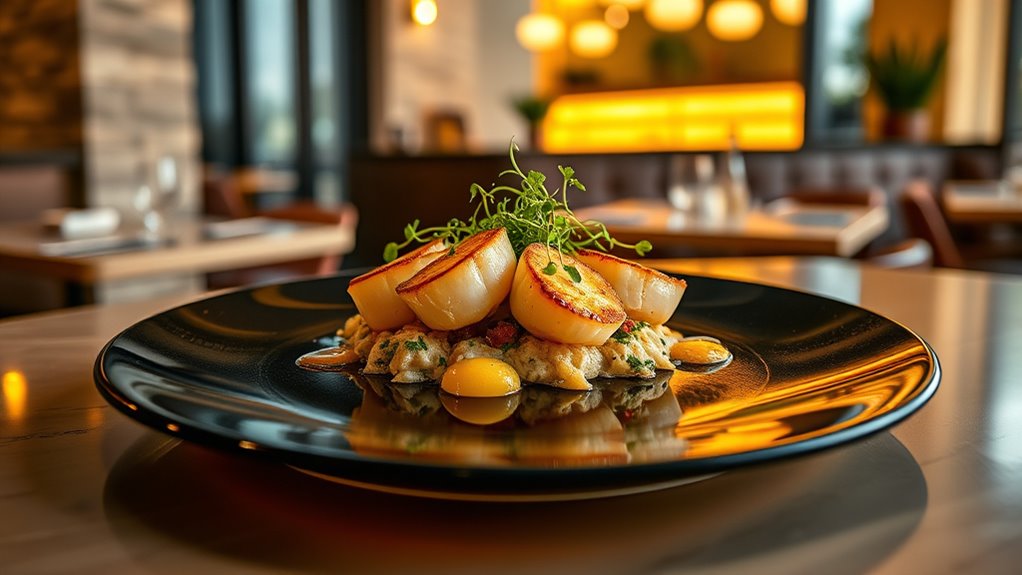
In 2025, New York City’s culinary scene continues to thrive with the addition of 16 new Michelin-starred restaurants, expanding the guide’s roster to over 350 establishments. This year’s newcomers showcase American culinary innovation, blending farm to table philosophies with diverse culinary heritage. You’ll find restaurants like Cafe Commerce, offering contemporary American dishes with French and Italian influences, and La Tête d’Or, a new steakhouse from Chef Daniel Boulud. Brooklyn’s neighborhoods shine with Middle Eastern flavors at Yemenat and bold Thai at Hungry Thirsty, reflecting the city’s multicultural vibrancy. The inclusion of locally sourced ingredients highlights the importance of nutritional value of seeds, which are increasingly incorporated into modern American cuisine to promote health-conscious dining.
Nordic Excellence: Celebrating the Top-Rated Countries
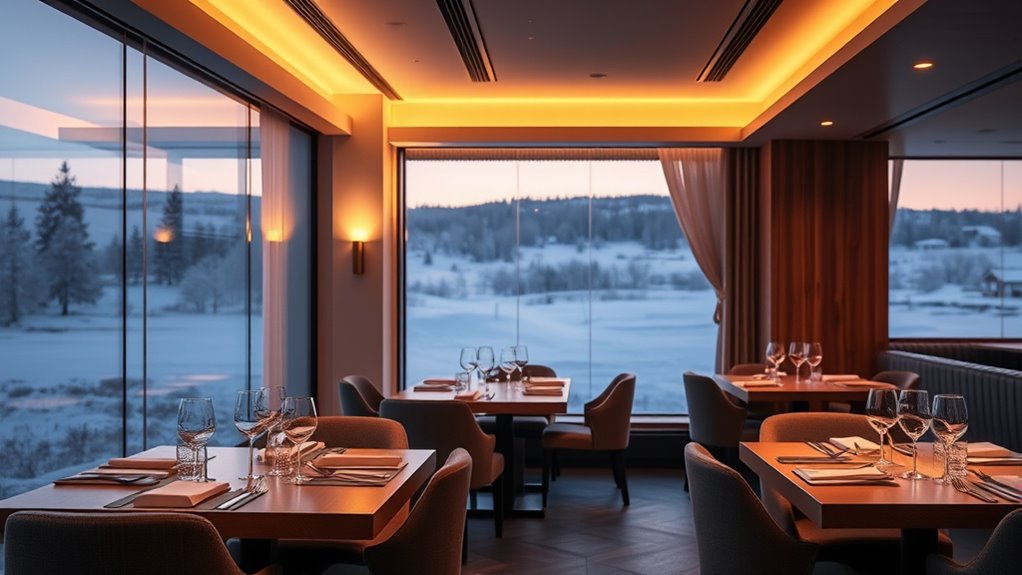
Denmark stands out in the 2025 Michelin Guide for the Nordic region, leading with the most new starred restaurants and sustainability awards. You’ll notice its strong focus on Culinary Heritage, blending traditional techniques with modern innovation. Many restaurants emphasize Ingredient Sourcing, prioritizing local, sustainable produce to craft authentic Nordic flavors. PAZ in Tórshavn debuts with two stars, showcasing hyper-local, reinterpreted cuisine rooted in the region’s landscape. Denmark also earns recognition through Green Stars, like Treetop, highlighting eco-conscious practices such as waste reduction and energy efficiency. With 39 Green Star restaurants, the region champions sustainability as part of its identity. Regular assessment and rotation of items ensure that the region maintains its commitment to responsible practices and continuous innovation. Overall, Nordic excellence in the guide reflects a commitment to honoring Culinary Heritage while leading responsible, mindful gastronomy on a global stage.
Noteworthy Restaurants Making a Debut
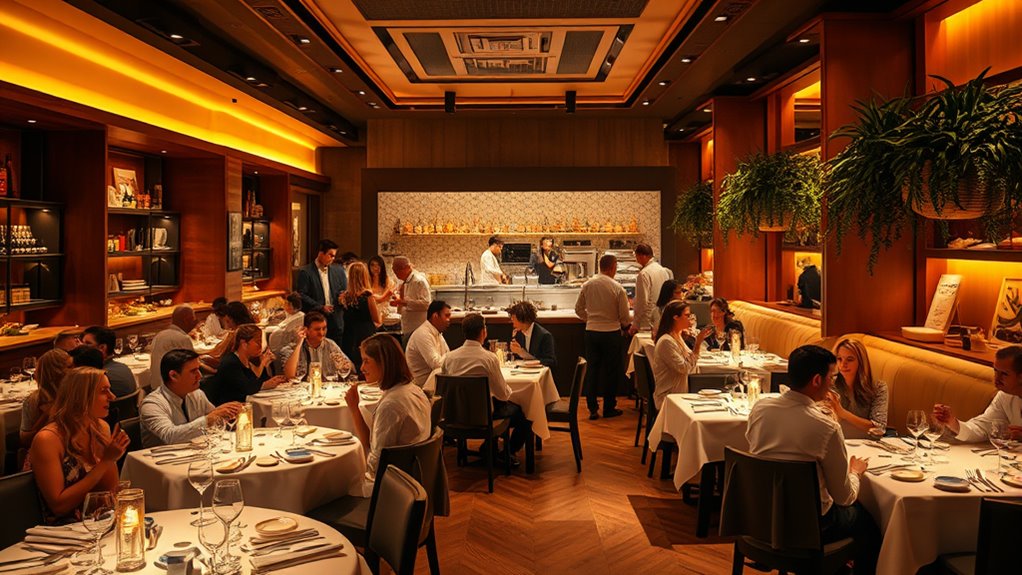
A vibrant group of 14 new restaurants has earned their place in the 2025 Michelin Guide New York, showcasing the city’s rich culinary diversity. These debut spots include eateries led by celebrity chefs and those participating in local food festivals, reflecting NYC’s evolving scene. Additionally, many of these establishments incorporate innovative techniques and culinary creativity to stand out in a competitive landscape.
- Yemenat offers traditional Yemeni dishes like lamb haneeth, drawing attention at food festivals for authentic flavors.
- Hungry Thirsty stands out with bold southern Thai curries and vibrant design, capturing the lively spirit of neighborhood dining.
- Café Kestrel and Mango Bay bring international flair to Red Hook and Fort Greene, emphasizing community-focused, globally inspired menus.
- Joomak and Kabawa introduce Korean and Japanese cuisines to the Michelin scene, highlighting the city’s multicultural palate.
These newcomers signal a fresh wave of culinary innovation, blending authenticity, bold flavors, and engaging atmospheres.
The Impact of Bib Gourmand and Green Star Recognition

Michelin’s Green Star and Bib Gourmand awards are transforming the culinary landscape by highlighting restaurants that prioritize sustainability and offer exceptional value. Green Star recipients showcase leadership in eco-friendly practices, including sustainable sourcing, local and seasonal ingredients, and regenerative farming techniques. These restaurants also implement energy-efficient measures and robust waste management systems, utilizing eco-friendly packaging for takeout. The recognition encourages chefs to innovate while reducing environmental impact, raising consumer awareness about sustainable gastronomy. Additionally, many Green Star restaurants incorporate antioxidants and vitamins to promote health-conscious dining experiences. Bib Gourmand, on the other hand, emphasizes delivering quality at moderate prices, often with a focus on approachable, well-sourced dishes. Both awards inspire restaurants to adopt greener practices and foster a culture of accountability, ultimately shaping a future where exceptional dining aligns with environmental responsibility.
Trends Shaping the Global Fine Dining Scene in 2025
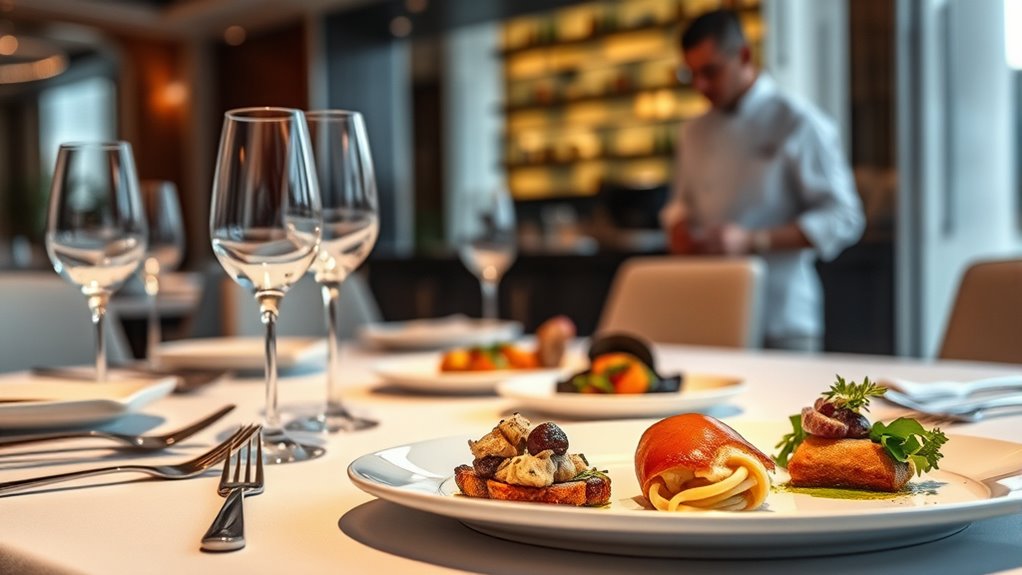
The global fine dining scene in 2025 is experiencing dynamic shifts driven by evolving consumer preferences and regional innovations. You’ll notice a surge in culinary collaborations and gastronomic storytelling, making dining more immersive. Comfort-oriented dishes now top menus, blending familiar flavors with haute cuisine techniques. Plant-based and flexitarian options are prevalent, reflecting health and sustainability priorities. Regions like Southeast Asia and China are leading a culinary renaissance, fusing traditional recipes with modern influences. Fusion elements from Middle Eastern, Korean, and Indian cuisines add diversity, while traditional American dishes see renewed popularity. Visual presentation, especially Instagram-worthy aesthetics, enhances appeal. Additionally, the emphasis on personalized experiences is transforming how diners engage with culinary artistry. These trends reshape expectations, emphasizing authenticity, storytelling, and sustainability in the ever-evolving global fine dining landscape.
Frequently Asked Questions
Which New Restaurants Received the Highest Michelin Ratings in 2025?
You’ll find that the highest Michelin ratings in 2025 go to a few standout restaurants earning three stars, recognized for their innovative plating and dessert innovations. In the US, California’s Providence, Somni, and Atelier Crenn shine, along with New York’s Jungsik. These top-tier spots impress with extraordinary culinary artistry, pushing boundaries and redefining fine dining, making them the must-visit destinations for an unforgettable gastronomic experience.
How Does Sustainability Influence Michelin’s Restaurant Evaluations in 2025?
Imagine your dining experience as a mirror reflecting your values. In 2025, Michelin’s restaurant evaluations go beyond taste, shining a spotlight on sustainability. You’ll see chefs prioritizing sustainable sourcing and using eco-friendly packaging, proving that caring for the planet is part of culinary excellence. These efforts influence ratings, encouraging restaurants to embrace responsible practices, making your meal not just delicious, but also a step toward a greener, more ethical future.
Are There Emerging Culinary Trends Seen Across Michelin-Starred Restaurants This Year?
You’ll notice emerging culinary trends across Michelin-starred restaurants this year, like the rise of plant-based menus that showcase creativity and seasonal ingredients. Fermentation techniques are also gaining popularity, adding depth and complexity to dishes. These trends reflect a focus on sustainability and innovation, enhancing your dining experience with unique flavors and textures. Expect to see chefs pushing boundaries and incorporating these techniques to craft memorable, forward-thinking meals.
Which Regions Are Gaining Recognition for Fine Dining Outside Major Cities?
You’ll notice regions outside major cities gaining recognition for fine dining, especially with a focus on rural gastronomy and coastal culinary destinations. Nordic countries expand beyond capitals, highlighting local produce and traditions. In Japan, Nara’s rural restaurants shine, while Florida’s emerging cities showcase innovative cuisine. France sees regional Michelin star growth in small towns, emphasizing provincial gastronomy. These trends reflect a shift toward celebrating local ingredients and lesser-known culinary hotspots.
How Are Michelin’S Green Star and Bib Gourmand Categories Evolving Globally?
You see Michelin’s Green Star and Bib Gourmand categories evolving globally by emphasizing eco-conscious dining and plant-based innovations. Restaurants now focus more on sustainability practices like local sourcing, zero-waste strategies, and regenerative farming, earning Green Stars. Meanwhile, Bib Gourmand highlights affordable, quality cuisine that often features plant-based options, making eco-friendly choices accessible. This shift encourages diners to seek out establishments committed to environmental responsibility, shaping a more sustainable and inclusive culinary landscape worldwide.
Conclusion
As you explore the 2025 Michelin stars, you’ll find the culinary world blossoming like a vibrant garden, full of surprises and new horizons. From tiny towns to bustling cities, these restaurants invite you to taste innovation and tradition alike. Get ready to set out on a delicious journey where every star guides you toward unforgettable experiences. So, pack your appetite—this year’s culinary landscape is more colorful and exciting than ever before.
